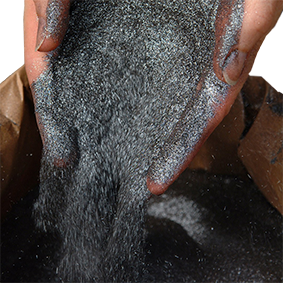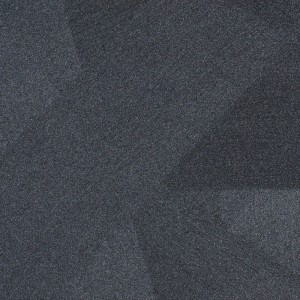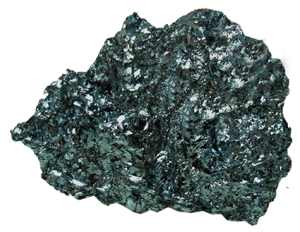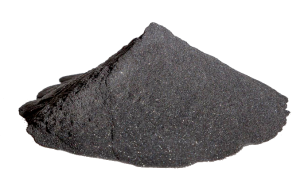Specular Hematite(Micaceous Iron Oxide)
Specular hematite, sometimes called “Micaceous Iron Oxide” has a metallic luster and appears to be a rock composed of shiny mica flakes. Instead those flakes are hematite. Even though this hematite has a silver color, it still produces a reddish streak – which is a key to hematite’s identification. Hardness testing on specular hematite is difficult because the specimens tend to crumble. This specimen is about four inches across (ten centimeters) and was collected near Republic, Michigan.
MIO pigment is used in paints to provide long-term durability. MIO paints have been used continuously since the early 1900’s to protect steel.
MIO, also known as specular haematite and flaky haematite, is a natural mineral ore that, after it is refined, consists mainly of Fe2O3. MIO differs in form and shape from the well-known iron oxides that are used as pigments for red, yellow, brown and black pigmentation. MIO shows a flaky, lamellar structure and is dark gray with a metallic sheen. The term “Micaceous” is used because the lamellar particles are similar to mica.
MIO is insoluble in water, organic solvents and alkalis and is only slightly soluble in strong acids at elevated temperatures. It is non-reactive with most chemicals and is heat-stable up to its melting point of over 1,500°C.
MIO – Micaceous Iron Oxide – is considered an anti-corrosive additive used in many kinds of paints and
Coating for over 100 years and is perhaps the most important barrier pigment used in coatings to protect Structural steel
The flake-like gray or red MIO particles align parallel to the coated surface producing a layer of shield of overlapping plates.
MIO usage
MIO is used widely in protective coatings due to its outstanding anti-corrosive properties. When MIO is incorporated into a coating at an appropriate level, the flakes align parallel to the substrate surface, producing a shield or barrier of overlapping plates. The flakes are impermeable—a physical barrier is formed to the ingress of the water, oxygen and ions that corrode steel and degrade the binder system. MIO flakes are strong UV absorbers and very weather-resistant. This protects the surface of the binder system from the degrading action of UV and other weathering elements. MIO reinforces the binder matrix and increases the substrate adhesion and inter-coat adhesion.
MIO is considered an anti-corrosive additive used in many kinds of paints and coating, it is perhaps the most important barrier pigment used in coatings to protect structural steel.
It is also used for durability and reliability on electrical and industrial equipment.
Industrial Applications
Due to high percentage of purity (91 to 98%) Ferric Oxide content, Micaceous Iron Oxide Powder has various industrial applications. Some of the important uses are narrated below:
Natural Micaceous Iron Oxide Powder is used in manufacturing of Electric Welding Rods and Electrodes (Arc Welding) Industries.
Micaceous Iron Oxide Powder is used as one of the ingredients of flux mixtures.
Leading Arc Welding Rods manufacturers are using the Micaceous Iron Oxide Powder.
Micaceous Iron Oxide Powder is used for bridge structural protective coatings, oil rig structural protective coatings, and protective coatings for all types of electrical and industrial equipment where durability and reliability are important.
Micaceous Iron Oxide has been successfully used in various paint primers with single or multiple topcoats in alkyd, epoxy, vinyl, acrylic, polyurethane, and chlorinated rubber.
MIO S natural Micaceous Iron Oxide (MIO). Its excellent platelet structure and high chemical resistance make it an ideal pigment in many anti corrosion paint formulations. MIO S paints provide long life corrosion protection for metallic structures in touch with very aggressive environments, such as marine and industrial ones.
Barrier effect
When MIO based paint is applied to a surface, the flaky pigment particles orientate themselves in multiple layers roughly parallel to the substrate in such a way that interleaving and overlapping take place. This barrier effect will reduce the diffusion of moisture and pollutants such as NaCl and SO2 through the medium, thus decreasing the chances of corrosion and blistering.
UV shielding effect
MIO particles are impervious to UV radiation and therefore protect organic binders from early degradation by light and UV rays. This is due to the coherent barrier and to the drastic Micaceous iron oxide absorption in the ultraviolet region.
Film reinforcement
Paint film reinforcement, which reduces film distortion, is due to the high aspect ratio of MIO and its preferable orientation parallel to the substrate. Consequently the film shows high mechanical properties and an improved cracking resistance.
Adhesion improvement
On galvanized surface, it has been shown that MIO enhances the adhesion of paint layers. Even allows one coat system to be efficient principally for high-voltage transmission towers. Moreover this pigment helps to obtain better re-coat ability, especially for epoxy coatings and thus reduces expensive and not very compliant surface treatment.
Thermal expansion
Major content of MIO is Fe2O3, which has a similar coefficient of thermal expansion to the metal substrate and consequently reduces flexing and cracking of the paint applied to the metal substrate.
Low soluble salts content
Soluble salts can form electrolytes in the paint system, and forming galvanic cells leads to film breakdown. MIO is extracted in deposits, which have particularly low soluble salts content. Moreover its air classification process removes most of the amorphous superfine particles, which lead to high soluble salt levels. SEM analysis of MIO shows the surface to be clean of superfine particles.
Food contact
Since MIO is free of toxic ingredients, it is extremely useful for nonpoisonous finishes applied to food processing plants such as sugar refineries, dairy plants, breweries and distilleries.
Coloration
MIO is grey with metallic sheen and is easily mixed with a large range range of pigments to obtain interesting dark shades (brown, red, grey…). TiO2 can be added to lighten the shade. Once again, by removing most of the amorphous super-fine particles, which are natural red oxide, air classification techniques help to ensure greater batch color control and consistency in batch-to-batch coloration


